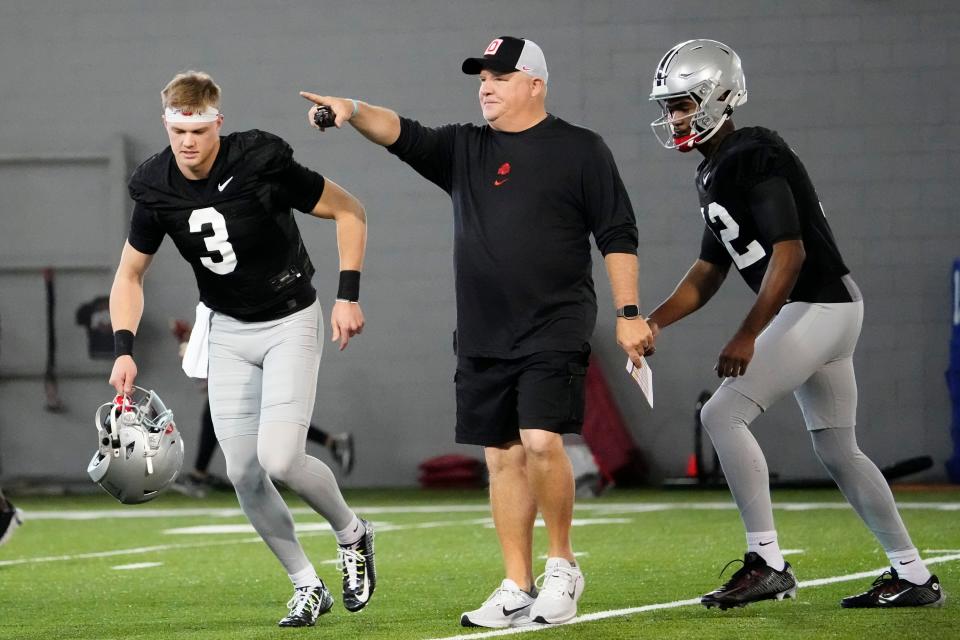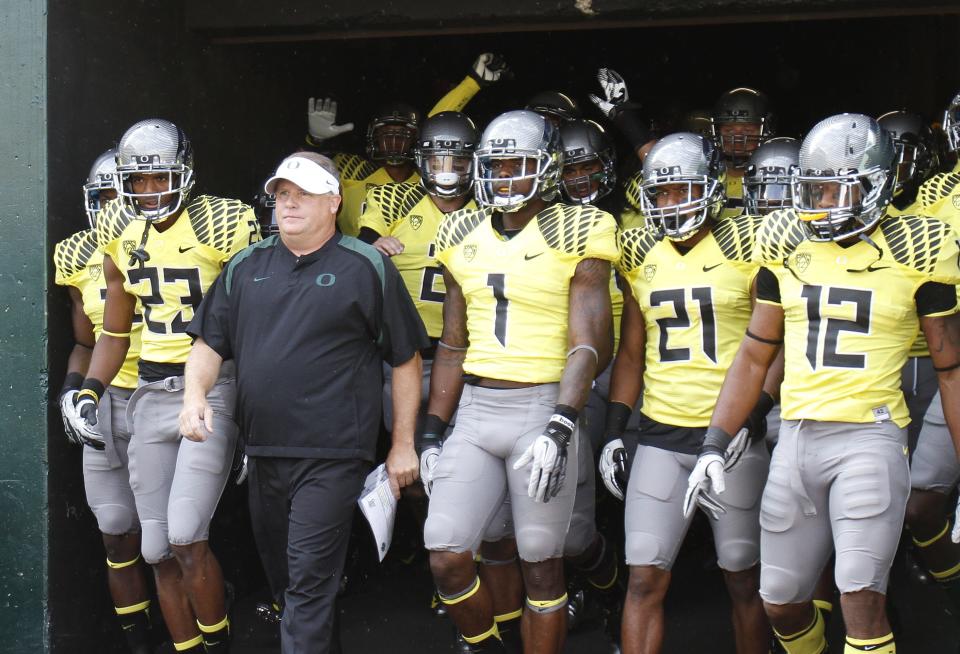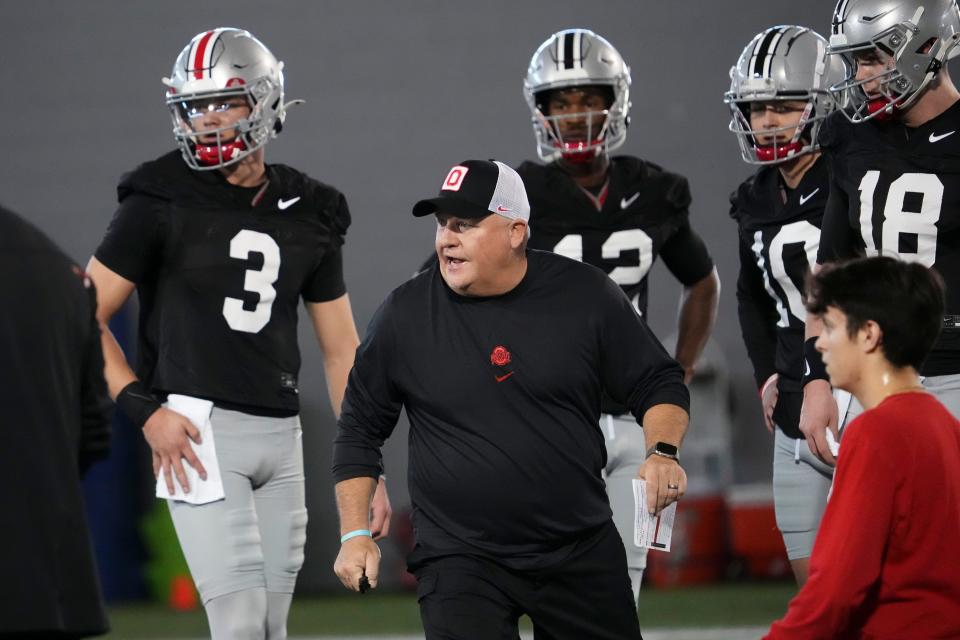Chip Kelly wants to add tempo to Ohio State’s offense as a side dish, not the main course
The infinite uniform combinations and hyper-speed offense put Oregon on the cutting edge of college football when Chip Kelly led the Ducks in the early 2010s.
But when he returned after four seasons in the NFL, taking over as the coach at UCLA in 2018, he found himself surrounded by imitators.
“Everybody had shiny helmets,” Kelly said, “and everyone was playing fast,”.

The proliferation of fast-paced, no-huddle offenses prompted a philosophical shift for a play-caller who had once fashioned an attack that operated at a pace so dizzying it became known as "the blur," revolutionizing the sport.
With the Bruins, Kelly reduced the speed, a change that is bound to carry over to Ohio State following his hiring last month as the Buckeyes’ offensive coordinator and quarterbacks coach.
“There are cycles to this game,” he said, “and once people catch on to that cycle, then it moves.”
Lest there be any confusion, UCLA was far from plodding under the direction of Kelly. The Bruins ran an average of 2.5 plays per minute of possession last season, a pace that was faster than the Buckeyes’ average of 2.2 plays a minute.
Yet Kelly’s offenses in Westwood did not operate at the same frenetic pace of those he ran in Eugene a decade earlier. In his last season with the Ducks in 2012, they averaged as many as 2.9 plays per minute as the second-highest scoring offense in the Football Bowl Subdivision.

High tempo, which thrives as a way for offenses to dictate pace and leave defenses with less time to adjust between plays, is no longer the singular quality.
“Tempo is part of an offense,” Kelly said, “but I don't think it's an offense in itself. It’s more like if you go to dinner, it's a side order. It’s not the main course. It's always good to have it.”
More: 'I want to be happy': Chip Kelly explains why he became Ohio State's offensive coordinator
As Kelly outlined his approach, he suggested the use of tempo would largely hinge on situations that emerge in games.
“There’s times when you'll use it,” he said, “but you're not going to use it extensively the entire game, just like you're not going to throw the ball every single snap or you're not going to run the ball every single snap.
“This is not a game of absolutes anymore. The ability to be diverse, and have it as a tool in your toolbox, so to speak, is really how we would look at using it.”
The Buckeyes have used tempo at times in Ryan Day’s tenure, a stretch that has produced its own share of high-scoring offenses, though the pace has slowed a little bit in recent seasons.

After averaging 2.4 plays per minute over Day’s first three seasons at the helm, they have averaged 2.2 over the past two.
Day said increasing tempo will be an element as he delegates more of the responsibilities of running the offense to Kelly.
“Will tempo be a part of it? Yes,” Day said. “Will we go fast every single play? No. Will we huddle every play? Probably not, but maybe. All the different ways that we're going to attack defenses is going to be exciting, but also mixing the tempos, the personnel groupings. Every team's a little bit different. It’s not cookie cutter.”
The motivation for Day to hire Kelly, his mentor who coached him when he was a quarterback at New Hampshire more than two decades ago, did not stem from a desire to simply speed up Ohio State’s offense.
While Day recognized Kelly’s inventiveness once reshaped offenses by ratcheting up the pace, Day also acknowledged it was not the extent of it.
“He’s always been innovative on how he's done things and put his players in the best situation to be successful,” Day said. “What does that look like right now in college football in 2024? That's the journey that we're on right now.”
More: Join the Ohio State Sports Insider text group with Bill Rabinowitz, Joey Kaufman Adam Jardy
Kelly confessed there are limits to clever schemes.
He pointed to the 3-4 defense that the New York Giants popularized after they won the Super Bowl in 1986.
“What people didn’t understand is they had Carl Banks and Lawrence Taylor,” Kelly said, referencing the star linebackers. "It didn’t matter what defense they were running. They could have been a four-down defense, and those guys would have been great players.
“The coaches that do it the best way insert their players and put them in the best position to make plays.”
For playing with tempo, that means picking the right spots.
Joey Kaufman covers Ohio State football for The Columbus Dispatch and can be reached at jkaufman@dispatch.com.
Get more Ohio State football news by listening to our podcasts
This article originally appeared on The Columbus Dispatch: Chip Kelly on using tempo as Ohio State football offensive coordinator
